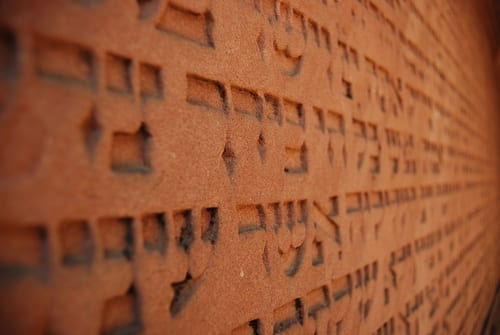These are the journeys of the Israelites who left the land of Egypt in their legions under the charge of Moses and Aaron. Moses recorded their starting points for their journeys according to the word of the Lord, and these were their journeys with their starting points.
They journeyed from Raamses in the first month, on the fifteenth day of the first month; on the day following the Passover sacrifice the Israelites left triumphantly before the eyes of all the Egyptians.
The Egyptians were busy burying [their dead] because the Lord had struck down their firstborn and had wrought vengeance against their deities. The Israelites journeyed from Raamses and camped in Succoth. They journeyed from Succoth and camped in Etham, at the edge of the desert.
They journeyed from Etham and camped in Pi ha-Chirot, which faces Baal Tzefon; and they camped in front of Migdol. They journeyed from Penei ha-Hirot and crossed in the midst of the sea to the desert.
They walked for three days in the desert of Etham and camped in Marah.They journeyed from Marah and arrived in Elim; in Elim were twelve springs of water and seventy palm trees and they camped there.
They journeyed from Elim and camped at the Reed Sea. They journeyed from the Reed Sea and camped in the Desert of Sinn. They journeyed from the Desert of Sinn and camped in Dofkah. They journeyed from Dofkah and camped in Alush. They journeyed from Alush and camped in Refidim, but there was no water for the people to drink. They journeyed from Refidim and camped in the Sinai desert.
They journeyed from the Sinai desert and camped in Kivrot ha-Ta’avah. They journeyed from Kivroth ha-Ta’avah and camped in Hatzerot. They journeyed from Hatzerot and camped in Ritmah.They journeyed from Ritmah and camped in Rimon Peretz. They journeyed from Rimon Peretz and camped in Livnah.They journeyed from Livnah and camped in Rissah. They journeyed from Rissah and camped in Kehelatah. They journeyed from Kehelatah and camped in Mount Shefer. They journeyed from Mount Shefer and camped in Haradah. They journeyed from Haradah and camped in Makhelot. They journeyed from Makhelot and camped in Tahat.
They journeyed from Tahat and camped in Tarach. They journeyed from Tarach and camped in Mitkah. They journeyed from Mitkah and camped in Hashmonah. They journeyed from Hashmonah and camped in Moserot. They journeyed from Moserot and camped in Benei Jaakan. They journeyed from Benei Jaakan and camped in Hor Hagidgad.
They journeyed from Hor Hagidgad and camped in Jotbatah. They journeyed from Jotbatah and camped in Abronah. They journeyed from Abronah and camped in Etzion Geber. They journeyed from Ezion Geber and camped in the desert of Tzin, which is Kadesh. They journeyed from Kadesh and camped at Mount Hor, at the edge of the land of Edom.
In his book, Guide for the Perplexed, Maimonides explains that the Torah lists all these journeys so that future generations would not think the Israelites wandered in the desert in areas comfortably adjacent to existing settlements and were therefore able to survive without the daily miraculous provision of food and drink and other
wonders (Maimonides, Guide for the Perplexed 3:5).
These journeys were stated in order to remove all such thoughts and to reinforce these wonders, so that future [generations] would see them and know the magnitude of the miracles.


The Pillar of Cloud
The Torah says that in all the Jewish people’s journeys in the desert, a pillar of cloud went before them by day and a pillar of fire by night to show them the way. In addition to this cloud that guided them, the Israelite camp was surrounded by six additional clouds protecting them on all sides. Altogether, these were the seven Clouds of Glory.
Their journeys and encampments were set according to when the pillar of cloud moved or rested: (Numbers 9:17-22)
At the cloud’s departure from over the Tent of Meeting… the Israelites would travel; and in the place where the cloud settled, there the Israelites would encamp.
There were places where they camped a very short time; and even before they had time to unload their equipment, they already had to continue their journey because the cloud began moving.
On the other hand, there were places where they camped for a number of days, or for months or even years. All this was determined by whether the cloud moved or remained stationary:
When the cloud lingered over the Tabernacle for many days, the Israelites kept the charge of the Lord and did not travel. Sometimes, the cloud remained for several days above the Tabernacle; at the Lord’s bidding they traveled, and at the Lord’s bidding they encamped.
Sometimes the cloud remained from evening until morning, and when the cloud departed in the morning, they traveled. Or, at some stops, the cloud remained for a day and a night, and when the cloud departed, they traveled.
Whether it was for two days, a month, or a year that the cloud hovered over the Tabernacle, the Israelites would encamp and not travel, but when it departed, they traveled. This is how they wandered during their years in the Sinai desert.
Their traveling and camping was unpredictable; it might be for a short or a long period, depending on whether the cloud that guided them began traveling or remained stationary, in accordance with God’s will.
In What Did the Israelites Live While in the Desert?
The Torah writes explicitly that in their wanderings in the wilderness, the Israelites lived in sukkot, “booths”: (Leviticus 23:43)
In order that your [ensuing] generations should know that I had the Israelites dwell in sukkot(booths) when I took them out of the land of Egypt. I am the Lord your God.
What is the meaning of the word sukkot? The Talmud presents two views about which it is said that “both are the words of the living God”and both are true: “I had the Israelites dwell in sukkot”—R. Eliezer says that they were the Clouds of Glory. Rabbi Akiva says it is referring to actual booths that He made for them.
As we saw above, the Jewish people were surrounded by miraculous Clouds of Glory, but in addition they built booths that were covered by tree branches.
Rabbi Tzvi Yehuda Berlin explains that they had two kinds of shelter, one made by
man, and the other by God: (In his commentary Ha’Emek Davar to Numbers 10:34) “When they were encamping, they set up physical booths. And when they were journeying, they had the Clouds of Glory.”
In other words, when they camped, they made actual booths to shield themselves from the harsh elements of the desert; but when they traveled, God shielded them spiritually and physically with the Clouds of Glory.
In remembrance of these structures that the Israelites dwelled in and the Clouds of Glory that surrounded them when they left Egypt, the Jewish people celebrate the festival of Sukkot until this very day.
On this holiday, every Jew leaves his home and goes to live for seven days under
a roof made of plant branches, while the walls can be made of stones or any other substance:
For a seven-day period you shall live in booths. Every native among the Israelites shall live in booths in order that your [ensuing] generations should know that I had the children of Israel live in booths when I took them out of the land of Egypt. I am the Lord, your God.
The Mishnah explains: “Anything that did not grow from the ground may not be used to cover a booth” (Talmud Sukkah 1:4).
The Manna—Abundant Food from the Sky Israel’s main food in the desert was manna, a wondrous food which descended from heaven: So the Lord said to Moses, “Behold! I am going to rain down for you bread from heaven” (Exodus 15:4).
Now, the manna was like coriander seed, and its appearance was like the appearance of crystal. The people walked about and gathered it. Then they ground it in a
Mill or crushed it in a mortar, cooked it in a pot and made it into cakes. It had a taste like the taste of an oil cake (Numbers 11:7-8).
In addition to the manna, on several occasions, the Israelites ate quail meat which God also provided them with: A wind went forth from the Lord and swept quail from the sea and spread them over the camp… and they gathered the quail… (Numbers 11:31-32).
Some of them also ate the sheep and cattle they had brought with them out of Egypt: The children of Israel journeyed from Raamses to Succoth… with flocks and cattle, a great amount of livestock.
Our Sages also mention that the Israelites conducted some trade with local merchants: “Foodstuff that the traders of other nations sold them…” (See Talmud
Yoma 75a).
Supernatural Water Supply
The Israelites were blessed with a miraculous well that accompanied them on their journeys, so they wouldn’t suffer from a lack of water in the desert, or from the blazing heat.
Although the desert contained a few oases with springs, these were clearly unable to provide the needs of millions of people throughout the forty years of wandering in the desert.
The well was called the “Well of Miriam” after the sister of Moses, because God gave it in the merit of her righteousness. The well always remained with them, except for brief periods when it disappeared because of the Israelites’ sins.
Adapted from ‘Hidden Treasures – Archaeology Discovers the Hebrew Bible’ by Rabbi Zamir Cohen. Click here to buy
Item: Alternative Au Viagra Féminin 4. Commander viagra usa. https://www.cialispascherfr24.com/ Viagra Feminin Ou Acheterviagrafr La dose pour les adultes est de 50 mg par jour.





